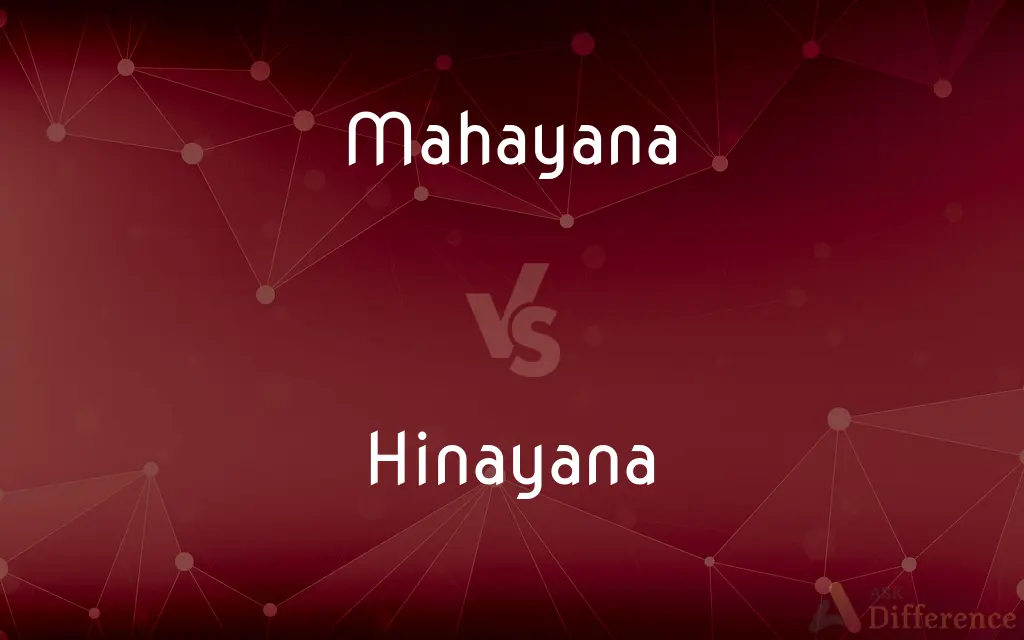Mahayana vs. Hinayana — What's the Difference?
By Fiza Rafique & Urooj Arif — Updated on April 26, 2024
Mahayana Buddhism emphasizes the path of the Bodhisattva aiming for universal enlightenment and compassion, whereas Hinayana, often termed Theravada, focuses on individual enlightenment and adheres closely to early Buddhist teachings.

Difference Between Mahayana and Hinayana
Table of Contents
ADVERTISEMENT
Key Differences
Mahayana Buddhism, meaning "Greater Vehicle," is known for its broad inclusivity, advocating enlightenment for all beings through the path of the Bodhisattva. This contrasts with what is commonly referred to as Hinayana (literally "Lesser Vehicle" but often considered a pejorative term) or more accurately Theravada, which means "Teaching of the Elders" and focuses on individual enlightenment through personal meditation and insight.
In Mahayana, the Bodhisattva ideal is central; adherents vow to become enlightened not just for themselves but to help all sentient beings achieve liberation from suffering. Conversely, in Theravada, the focus is on achieving Arhatship, a state where the individual becomes liberated from the cycle of birth and rebirth, emphasizing personal wisdom and meditation practices.
Mahayana texts include a vast array of sutras, including the Lotus Sutra and the Heart Sutra, which introduce concepts like the emptiness of all phenomena and the universal potential for Buddhahood. Theravada relies on the Pali Canon, the oldest Buddhist scriptures, which offer a more conservative interpretation of Buddha's teachings, emphasizing ethical conduct and monastic discipline.
Geographically, Mahayana Buddhism spread through North and East Asia, profoundly influencing cultures in China, Japan, Korea, and Tibet. Theravada is primarily practiced in Sri Lanka, Thailand, Laos, Cambodia, and Myanmar, where it influences local practices and daily life deeply.
While both branches agree on the core doctrines of Buddhism like the Four Noble Truths and the Eightfold Path, Mahayana Buddhism introduces the upaya (skillful means), a method that adapts teachings to suit different levels of understanding and spiritual maturity. Theravada maintains a more traditional approach, adhering strictly to the path laid out by the historical Buddha.
ADVERTISEMENT
Comparison Chart
Core Ideal
Bodhisattva path to save all beings
Arhat path for personal liberation
Scriptures
Includes Mahayana Sutras like the Lotus Sutra
Relies on the Pali Canon
Philosophy
Emptiness of all phenomena, universal Buddhahood
Focus on personal insight and enlightenment
Geographic Spread
Predominant in North and East Asia
Predominant in Southeast Asia
Teaching Method
Upaya (skillful means), adaptive teaching methods
Conservative, strict adherence to original teachings
Compare with Definitions
Mahayana
Practices the path of the Bodhisattva.
Practitioners of Mahayana aim to attain Buddhahood for the benefit of all sentient beings.
Hinayana
The oldest form of Buddhism, focusing on individual enlightenment.
Theravada practitioners follow a strict monastic life to achieve Nirvana.
Mahayana
A major branch of Buddhism that seeks enlightenment for all beings.
Mahayana Buddhism encourages the practice of meditation and compassion to achieve universal salvation.
Hinayana
Emphasizes the attainment of Arhatship.
An Arhat in Theravada Buddhism has overcome all desires and reached liberation.
Mahayana
Utilizes a wide array of sutras and philosophical texts.
The Heart Sutra, revered in Mahayana, teaches about the nature of emptiness.
Hinayana
Predominantly practiced in Southeast Asia.
In Thailand, young men often become monks for a period as part of their religious duty.
Mahayana
Prominent in China, Japan, and Tibet.
Zen Buddhism, a form of Mahayana, emphasizes sudden enlightenment through meditation.
Hinayana
Based on the Pali Canon as the primary scripture.
The Dhammapada, part of the Pali Canon, contains the sayings of the Buddha.
Mahayana
Mahāyāna (; "Great Vehicle") is a term for a broad group of Buddhist traditions, texts, philosophies, and practices. Mahāyāna Buddhism developed in India (c.
Hinayana
Stresses monastic discipline and meditation.
Daily life in Theravada monasticism involves repetitive meditation and adherence to precepts.
Mahayana
One of the major schools of Buddhism, traditionally active in much of Nepal, Tibet, and East Asia and emphasizing compassion and the possibility of universal salvation.
Hinayana
"Hīnayāna" () is a Sanskrit term literally meaning the "small/deficient vehicle". Classical Chinese and Tibetan teachers translate it as "smaller vehicle".
Mahayana
A major school of Buddhism teaching social concern and universal salvation, found in China; Japan; Tibet; Nepal; Korea; and Mongolia.
Hinayana
(Offensive) Theravada Buddhism.
Mahayana
One of two great schools of Buddhist doctrine emphasizing a common search for universal salvation esp through faith alone; chiefly in China; Tibet; Japan.
Hinayana
A major school of Buddhism teaching personal salvation through one's own efforts.
Mahayana
A major school of Buddhism teaching social concern and universal salvation; China; Japan; Tibet; Nepal; Korea; Mongolia
Hinayana
One of two great schools of Buddhist doctrine emphasizing personal salvation through one's own efforts; chiefly in Sri Lanka (Ceylon); Myanmar (Burma); Thailand; Cambodia.
Mahayana
One of two great schools of Buddhist doctrine emphasizing a common search for universal salvation especially through faith alone; the dominant religion of China and Tibet and Japan
Hinayana
A major school of Buddhism teaching personal salvation through one's own efforts
Mahayana
Adapts teachings for various followers through upaya.
Mahayana Buddhism often uses parables and stories to convey deep truths.
Hinayana
An offensive name for Theravada Buddhism
Common Curiosities
What roles do meditation play in Mahayana and Theravada?
Both traditions emphasize meditation but in different contexts; Mahayana for cultivating compassion and skillful means, and Theravada for achieving personal insight and liberation.
What is the main philosophical difference between Mahayana and Theravada Buddhism?
Mahayana focuses on universal salvation and the emptiness of phenomena, while Theravada concentrates on individual enlightenment and personal purity.
Why is the term "Hinayana" considered pejorative?
"Hinayana" implies a "lesser vehicle," suggesting an inferior path compared to Mahayana's "greater vehicle." It's more respectful to use "Theravada."
Can one switch from Theravada to Mahayana practices?
Yes, Buddhist practices are adaptable, and individuals may find elements from both traditions that resonate with their spiritual goals.
How do Mahayana and Theravada view the concept of Buddhahood?
Mahayana holds that all beings can achieve Buddhahood, whereas Theravada believes that reaching Arhatship, a state free from desires and suffering, is the ultimate goal.
How does the geographic spread affect the practice of these Buddhist branches?
Cultural, historical, and geographical differences have led to distinct expressions of Buddhism in different regions, influencing local customs and practices.
Is vegetarianism required in both Mahayana and Theravada?
Vegetarianism is more emphasized in Mahayana due to its focus on compassion for all beings, while Theravada does not strictly require it.
What is the significance of monastic life in both traditions?
Monastic life is central to both, but Theravada places a stronger emphasis on monastic discipline as a means to achieve enlightenment.
How do Mahayana and Theravada interpret the Four Noble Truths?
Both agree on the fundamental truths, but their interpretations and emphasis on certain aspects, like suffering and the path to its cessation, can vary.
What are some major festivals in Mahayana and Theravada Buddhism?
Mahayana celebrates events like Bodhi Day (Buddha’s enlightenment), while Theravada observes Vesak, the Buddha’s birth, enlightenment, and death.
Share Your Discovery

Previous Comparison
Acrylamide vs. Polyacrylamide
Next Comparison
Monosaccharide vs. PolysaccharideAuthor Spotlight
Written by
Fiza RafiqueFiza Rafique is a skilled content writer at AskDifference.com, where she meticulously refines and enhances written pieces. Drawing from her vast editorial expertise, Fiza ensures clarity, accuracy, and precision in every article. Passionate about language, she continually seeks to elevate the quality of content for readers worldwide.
Co-written by
Urooj ArifUrooj is a skilled content writer at Ask Difference, known for her exceptional ability to simplify complex topics into engaging and informative content. With a passion for research and a flair for clear, concise writing, she consistently delivers articles that resonate with our diverse audience.













































